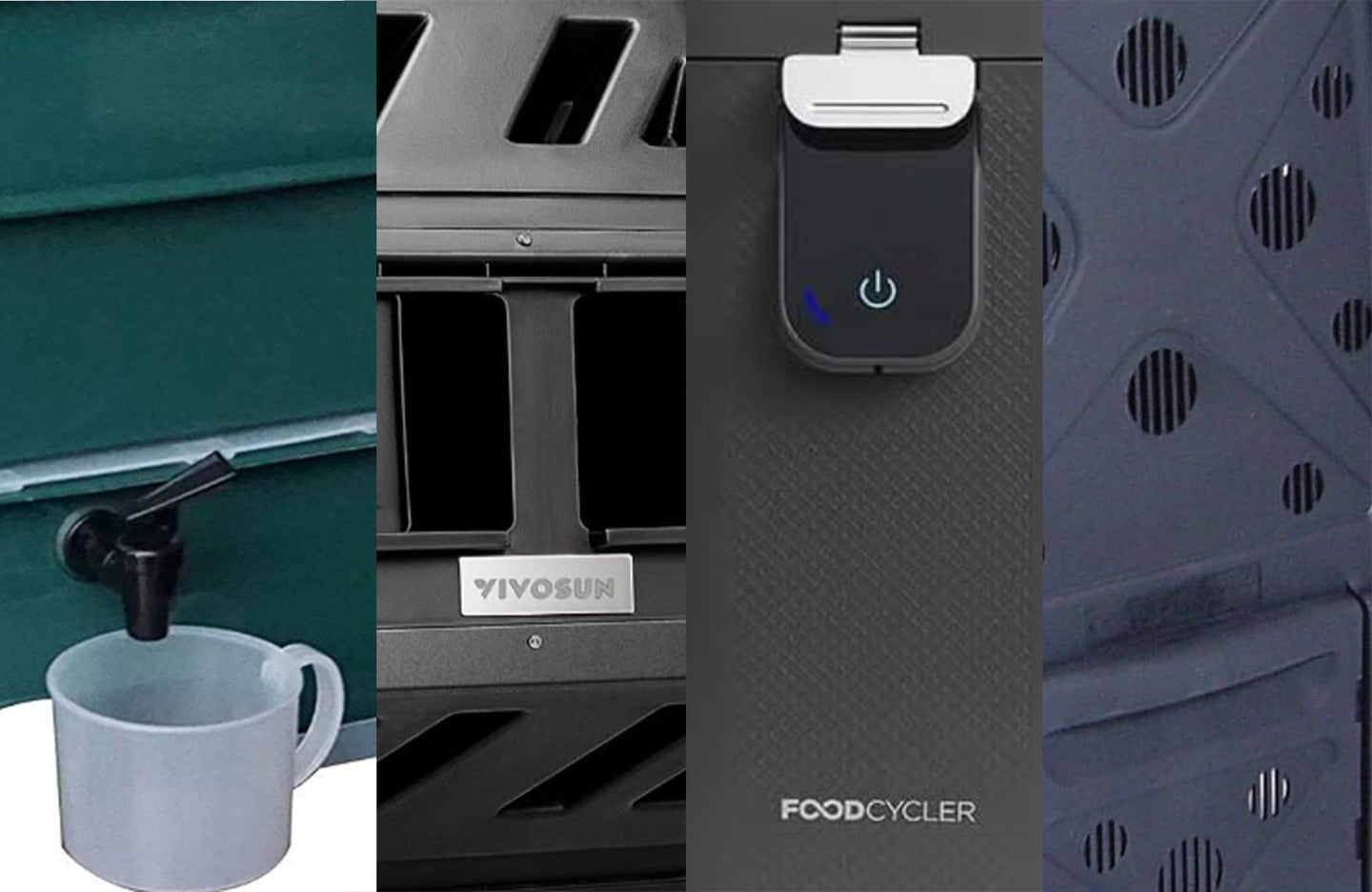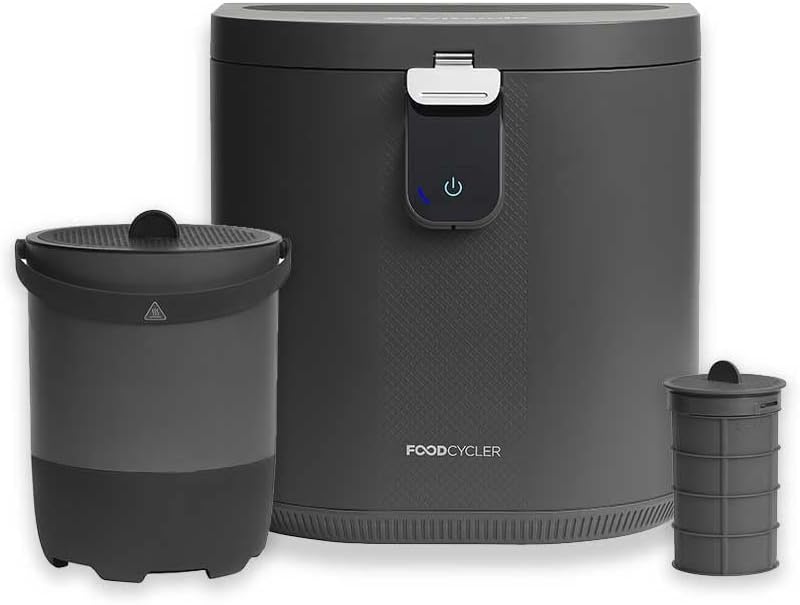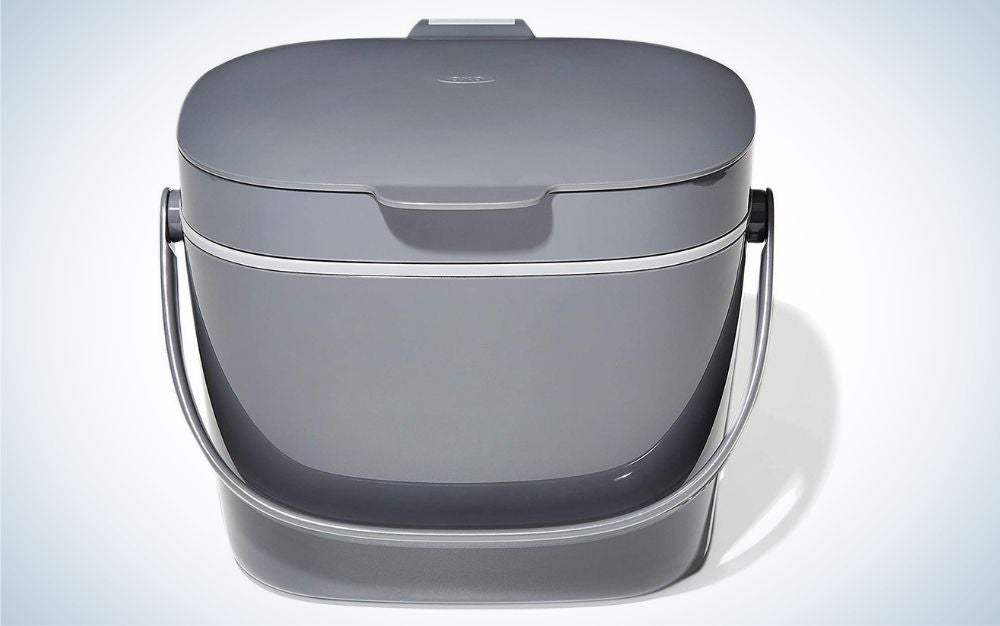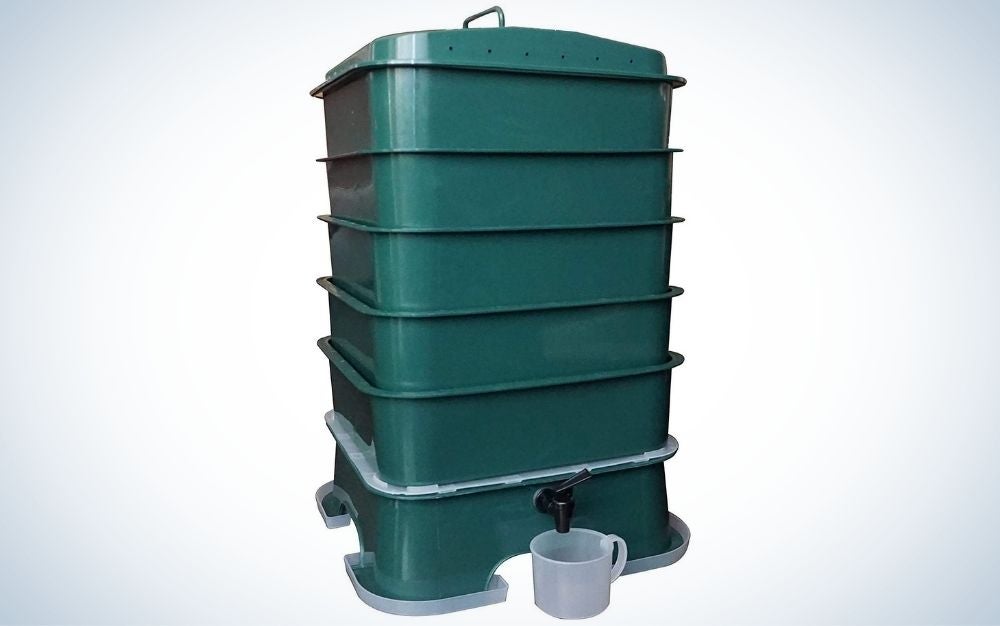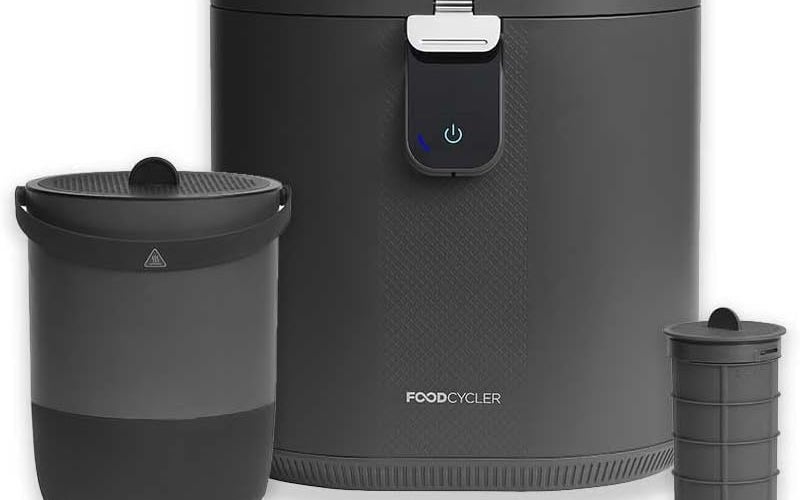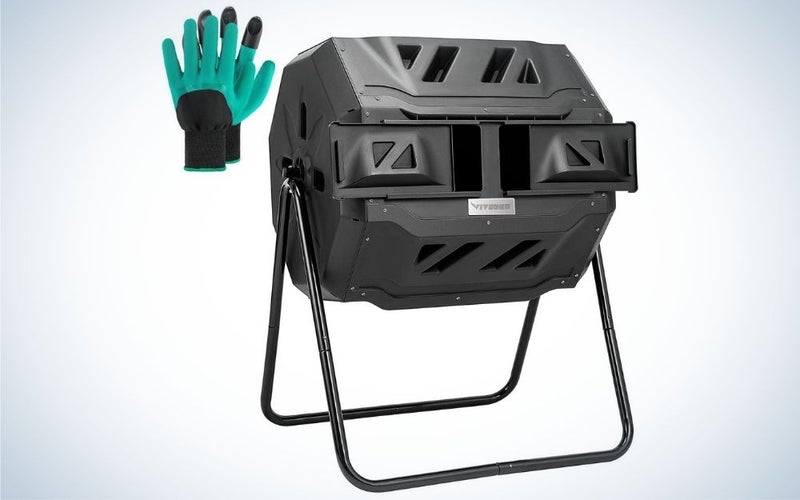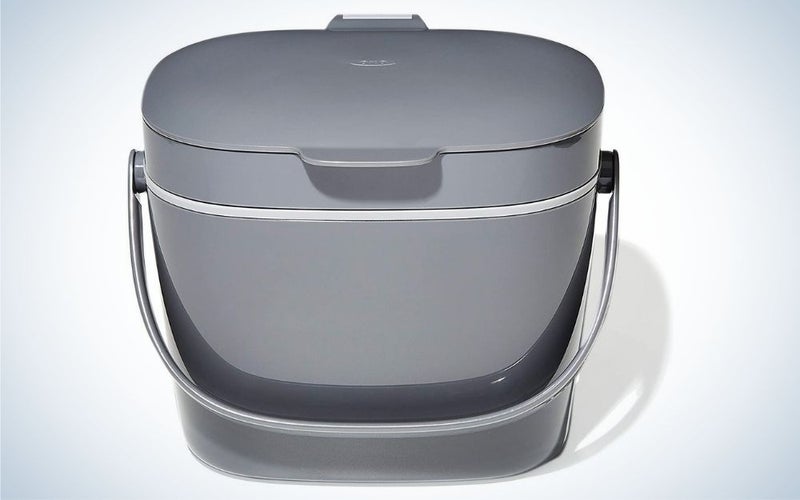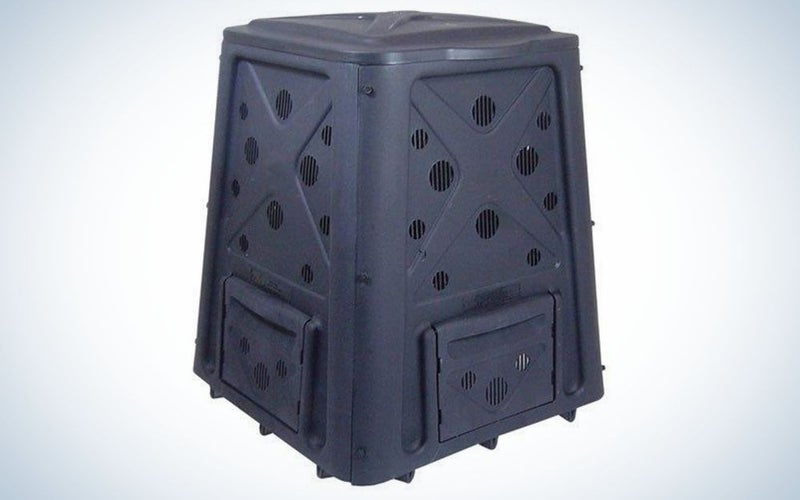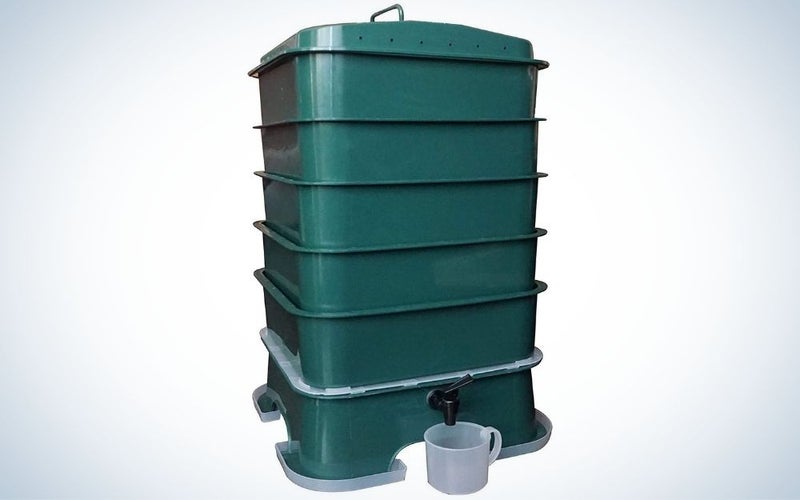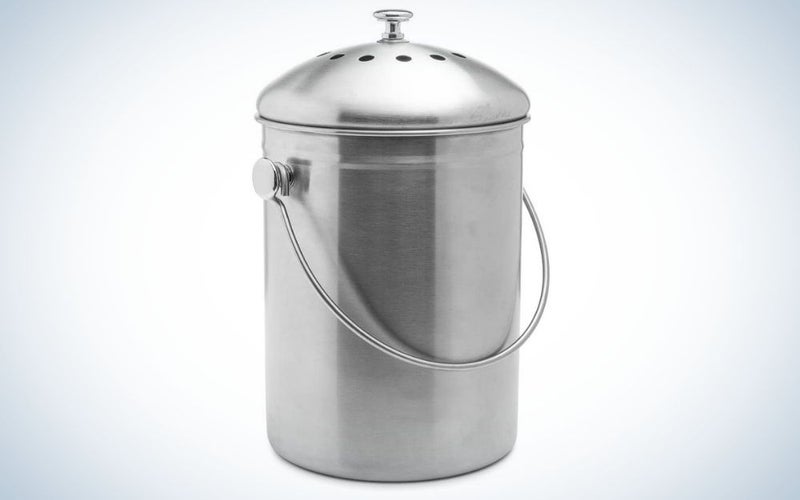We may earn revenue from the products available on this page and participate in affiliate programs. Learn more ›
Whether you’re looking to nourish your potted plants, foster a prized vegetable garden, or do your part to reduce food waste, an indoor composter is an environmentally friendly and effective way to turn your food scraps into usable dirt. But if you’re new to composting, it can be confusing to find the best compost bins. The good news is that composting at home is easier than you think, and it’s a great way to put your inedible and leftover food to good use. The canisters and bins on this list help initiate the process of breaking down food into nutrient-dense soil in which plants can thrive.
- Best overall: Eco 5 FoodCycler by Vitamix
- Best tumbling: VIVOSUN Tumbling Compost Bin
- Best countertop: OXO Good Grips Compost Bin
- Best pallet: Redmon Compost Bin
- Best worm bin: VermiHut Plus Worm Compost Bin
- Best budget: EPICA Compost Bin
How we chose the best compost bins
As a year-round home composter (yes, even through New England winters), as well as a vegetable gardener, I know how valuable the rich, nutrient-dense soil in a compost pile is as a fertilizer. And as a chef and home cook, I want to do everything I can to reduce the massive amounts of food waste in America. So, my list of best compost bins reflects personal experience, product testing, and research, including customer reviews and product specs. These composters are eco-friendly and easy to use. They’ll minimize smells in your kitchen and help your family turn regular food scraps into nourishing soil for your next produce crop.
The best compost bins: Reviews & Recommendations
According to the National Resources Defense Council, composting “adds nutrients and organic matter back to the soil,” a.k.a. black gold. This “benefits agriculture, reduces our reliance on synthetic fertilizers, diverts methane-producing organic materials from landfills, and improves soil’s water retention capacity so you don’t need to water as much.” Plus, composted soil is said to produce more delicious fruits and vegetables.
Despite how complicated it may sound, all you really need is the right composting bin or compost barrel and the desire to help the environment. Beyond that, according to the EPA, just find a shady, dry spot for your bin and moisten dry materials before you add them to the heap.
Best overall: Eco 5 FoodCycler by Vitamix
Vitamix
Specs
- Material: Plastic
- Capacity: 5 liters
- Dimensions: 10.9 inches L x 13.5 inches W x 13.8 inches H
- Weight: 29 pounds
Pros
- Turns compost into soil-grade material you can immediately use
- Quiet
- Large capacity
Cons
- Expensive
Vitamix is known for making high-functioning kitchen appliances, and this indoor electric composter is no exception. Though it’s not cheap, this quiet and thorough food cycler does the job well every time and will last for years of regular use, making it one of the best compost bins. To operate the Vitamix machine, dump food scraps (including poultry bones, fruit rinds, and coffee grounds) into the interior bucket. Press the power button and walk away. The machine will first dehydrate, then grind your leftovers into a dry powder that’s compact, light, and easy to transport to the garden.
The machine stays quiet and keeps smells at bay, thanks to interior carbon filters. This model also features reusable filters that you can fill with new carbon pellets for even more sustainability.

We’re also a fan of Vitamix’s smaller (and more affordable) FoodCycler FC-50, shown here. Just toss your vegetable peelings, egg shells, coffee grounds, and even chicken bones into the 2-liter container and press the on button. About four hours later, your scraps are turned into nutrient-rich soil you can use for your houseplants or in your garden.
Best tumbling: VIVOSUN Tumbling Compost Bin
VIVOSUN
Specs
- Material: Plastic, metal
- Capacity: 43 gallons
- Dimensions: 26.25 inches L x 23.6 inches W x 36.5 inches H
- Weight: 21.7 pounds
Pros
- Large capacity
- Two chambers allow for different stages of composting
- Air vents allow for circulation
- Affordable
Cons
- May be too large for small households
- Expensive
This rotating batch compost bin is easy to use and mess-free. Two chambers let you alternate dual batches of compost, while the convenient tumbler lets you mix without getting your hands dirty. Adjustable air vents provide aeration for oxygen-rich soil, and a pair of garden gloves (included) let you excavate and plant your yard safely.
Best countertop: OXO Good Grips Compost Bin
OXO
Specs
- Material: Plastic
- Capacity: 1.75 gallons
- Dimensions: 8.3 inches L x 10.15 inches W x 12 inches H
- Weight: 1.63 pounds
Pros
- Attractive
- Combats odor
- Easy to clean
Cons
- Small capacity
Though it has a small footprint, this OXO style gets the job done. Oxygen flows through the soft-close lid to combat odor and insects. It can also be switched to stay-open mode for ease when tossing in scraps. The internal bucket is removable and can be popped in the dishwasher, and its handle makes it easy to carry outside.
Best pallet: Redmon Compost Bin
Redmon
Specs
- Material: Plastic
- Capacity: 6.62 liters
- Dimensions: 13 inches L x 13 inches W x 8 inches H
- Weight: 15 pounds
Pros
- Large capacity
- Weather-resistant
- Composter and turning tool in one
- Aeration built in
Cons
- May be too large for small households
Four access doors plus a top-lid make it easy to get scraps in and compost out. At 15 pounds empty and 26-by-26-by-30.75 inches, set it and forget it. Plus, this Redmon compost bin is made of post-consumer, UV-stabilized material that’ll stand up to all sorts of weather.
Best worm bin: VermiHut Plus Worm Compost Bin
VermiHut
Specs
- Material: Plastic
- Capacity: 40 liters
- Dimensions: 17 inches L x 17 inches W x 33 inches H
- Weight: 15 pounds
Pros
- Large capacity
- Incorporates worms
- Easy to set up
Cons
- Some users say some worms escape
This 17-by-17-by-33-inch multi-tray option has additional components like an ant trap, plus multiple boards made of different materials (e.g., coconut fiber) for moisture control, fruit-fly deterrence, and odor removal.
Best budget: EPICA Compost Bin
EPICA
Specs
- Material: Stainless steel
- Capacity: 40 liters
- Dimensions: 7.16 inches L x 7.16 inches W x 11 inches H
- Weight: 12 pounds
Pros
- Made of stainless steel
- Features charcoal filter to fight odor
- Affordable
Cons
- No active composting function
- Not very large capacity
This rust- and leak-proof Epica composting bin option controls odor with an airtight lid and replaceable charcoal filter. Plus, it won’t leach any toxic chemicals into your compost.
What to consider when shopping for compost bins
Depending on how green (or not so green!) thumb your thumb is, ease of use should be the first consideration when choosing the best compost bin. The good news is that most models are relatively simple to operate. The right mix of materials—greens like foodstuffs and browns like newspaper and leaves—guarantees a nearly odor-free process. Beyond that, the process comes down to how much space you have and whether you’re comfortable adding insects to the mix.
Do you want an indoor compost bin or an outdoor compost bin?
The biggest variable between indoor and outdoor styles is odor. Composting—which, in essence, is accomplished by decay—can get stinky. Indoor composters tend to be smaller and more airtight, and they sometimes come with built-in filters. You could use your indoor bin as a layover for the backyard, i.e., a place to store scraps that eventually and quickly go into the bigger bin out back, assuming you don’t want what is essentially dirt and decay sitting on your countertop for weeks.
Would you prefer a nice and neat composting bin that fits on your countertop?
The upside to a countertop compost bin is that it’s small and tidy-looking, and you won’t have to schlep to the backyard every time you need to deposit a banana peel. The downside is, well, it’s small. Not just that, but without the tumbler feature of many outdoor models, you’ll either eventually have to transfer the contents of your countertop contraption to an outdoor one or do the tumbling yourself, i.e., using your hands or tools to mix the compost components together. Think of a countertop style as an add-on, not a fully functional composting system in and of itself (especially since it takes weeks for compost to fully develop).
If you want an outdoor compost bin, how many chambers would you like?
Compost barrels and bins tend to come in two varieties: single- and multiple-chamber. The main difference is that a multiple- or dual-chamber composter allows you to compost multiple batches on a rolling basis. For example, you can keep adding waste to one chamber while the other cooks). Technically, you don’t even need a bin to compost (though it certainly makes it easier). Those with greener thumbs can create a compost pit or trench in the yard, no bins or barrels required. If ease is what you’re after, a dual-chamber tumbler—so you don’t have to manually mix the compost—is the way to go.
Are you cool with worms?
If you said, “Heck yes, I’m cool with worms!” that’s great news. The addition of worms can speed up the composting process in multiple ways. The worms eat all the food scraps you’ve put in the bin, and when they come back out again, voilà, it’s compost now! Also, their penchant for tunneling creates a naturally aerated environment for the decay to happen. If you’re down with worms, invest in a batch of red wigglers, a particularly efficient type of worm, at your local nursery or through Amazon. If you have an open-bottom composting bin in your backyard, no need to buy your own worms. The earthworms already in your yard will naturally gravitate to it. And if you’re more than just a little interested in worms, you could try creating your own wormery, a.k.a. vermicomposting.
How do I know what’s compostable and what’s not?
Eventually, you’ll get a natural sense for what you can and cannot compost. Until then, just defer to a trusted source, like the NRDC. As a general rule, avoid anything treated with pesticides, feces, dairy, charcoal, or fats. Do opt for leaves, shredded newspaper, coffee grounds, tea bags, and fruits and veggies.
FAQs
Q: What is the best composter for beginners?
The great news is that all composters are beginner-friendly! The choice comes down to whether you want to store your scraps inside, throw it all in a continuous composter outside, work on multiple compost batches with a multiple-chamber model, and whether you’re interested in a tumbling option. All are easy; they just require the right ingredients, tools, time, and expectations.
Q: How often should you turn your compost?
Answers vary: Some sources say every four to five weeks. Others say two or three times a week. Others still say every seven to 14 days. Talk to the people at your local gardening center to get an answer. The key is not to over-turn. Too much tumbling will wreak havoc on your compost. It’ll disperse the heat inside the chamber, which is needed for the compost to cook.
Q: How do I choose a compost bin?
Think about the space you have (a giant backyard or no outdoor real estate?), how much you want to spend, whether you want a compact style you can place on the countertop, whether you want the option to tumble, and if you want to cook more than one batch of compost at a time. You can always start with an affordable, small countertop version. If you find yourself loving the compost life, upgrade to a bigger, hardier backyard style.
Final thoughts on the best compost bins for you
- Best overall: Eco 5 FoodCycler by Vitamix
- Best tumbling: VIVOSUN Tumbling Compost Bin
- Best countertop: OXO Good Grips Compost Bin
- Best pallet: Redmon Compost Bin
- Best worm bin: VermiHut Plus Worm Compost Bin
- Best budget: EPICA Compost Bin
A composter is a can’t-lose proposition! Just deciding to give composting a go means you’re on your way to living more sustainably and potentially growing more delicious food for your family. Composting reduces the need for chemical fertilizers and lowers your carbon footprint. Which particular bin, barrel, or tumbler you choose comes down to your comfort level, personal taste, and aesthetic. Just pick the one that speaks to you, and you’ll be on your way to eco-hero status in no time.
Why trust us
Popular Science started writing about technology more than 150 years ago. There was no such thing as “gadget writing” when we published our first issue in 1872, but if there was, our mission to demystify the world of innovation for everyday readers means we would have been all over it. Here in the present, PopSci is fully committed to helping readers navigate the increasingly intimidating array of devices on the market right now.
Our writers and editors have combined decades of experience covering and reviewing consumer electronics. We each have our own obsessive specialties—from high-end audio to video games to cameras and beyond—but when we’re reviewing devices outside of our immediate wheelhouses, we do our best to seek out trustworthy voices and opinions to help guide people to the very best recommendations. We know we don’t know everything, but we’re excited to live through the analysis paralysis that internet shopping can spur so readers don’t have to.
